Cultivar Differences in Nitrogen Uptake,Utilization and Field Nitrogen Balance of Maize Hybrids in Response to Nitrogen Management
2022-09-14LIQiangKONGFanleiYUANJichao
LI Qiang,KONG Fanlei,YUAN Jichao
(1.Chongqing Key Laboratory of Economic Plant Biotechnology,Collaborative Innovation Center of Special Plant Industry in Chongqing,Institute of Special Plants,Chongqing University of Arts and Sciences, Chongqing 402160,China;2.Key Laboratory of Crop Ecophysiology and Farming System in Southwest China, Ministry of Agriculture,College of Agronomy,Sichuan Agricultural University,Chengdu 611130,China)
Abstract: To increase crop yields,reduce the application of chemical fertilizers,and improve nutrient utilization efficiency,N-efficient maize cultivars were screened and popularized. An understanding of nitrogen uptake,utilization,and field balance in maize cultivars with contrasting nitrogen efficiency response to N management is essential for efficient breeding and cultivation of maize to produce fodder and bio-energy. To determine the effects of N management on these factors during maize cultivation,a two-year field experiment was conducted in 2015 and 2016 in a subtropical semi-humid climate zone. The results showed that the proportion of N in the stem plus sheath and leaves in ZH311 during VT and R6 was significantly higher than that of XY508. In addition,the N accumulation into grain post-silking(NAG)and contribution of NAG to grain(CNAG)of ZH311 were significantly higher than those of XY508,while the N redistribution rate(NRR)and contribution of NRA to grain yield(CNRA)of ZH311 were significantly lower than those of XY508. The higher proportion of N in the vegetative organs of a N-efficient cultivar,ZH311,led to a significantly higher N accumulation in each stage than that observed for the N-inefficient cultivar XY508. The N accumulation advantage of ZH311 was higher after silking than before silking. The high post-silking N accumulation of ZH311 inhibited the pre-silking N transport that determines the N transport rate and contribution rate to grain of pre-silking N accumulation,which were significantly lower than those of XY508. Meanwhile,the N uptake efficiency,N recovery efficiency,and N partial productivity of ZH311 were significantly higher than those of XY508. Compared with that of XY508,the root system of ZH311 could more effectively absorb and utilize inorganic N in the 40—80 cm soil layer,reduce N deposition,and significantly decrease apparent N losses. The differences in apparent N losses between the two cultivars were mainly elicited post-topdressing. In summary,ZH311 has not only a higher yield per unit area than XY508,but also lower N losses,consequently reducing environmental risks.
Key words: Maize;Nitrogen management;Inorganic N;Nitrogen balance
Maize(ZeamaysL.)crops over 177 million ha worldwide and their total yield exceeds that of all other grains[1].Maize production by 2050 should be double that in 2005 to meet the growing demand for food and bio-fuels[2]. However,with the expansion of infrastructure,industrialization,and urban encroachment,arable land area has shrunk rapidly in recent years[3]. Meanwhile,the current scenario of environmental disasters and the concurrent need for adequate food productivity makes it essential to consider approaches that simultaneously sustain both the environment and food economy[4].
N is typically considered to be the most influential factor for crop productivity and grain quality,and N fertilizer is widely used to increase yield and profit[5]. In China,several farmers apply more chemical N fertilizer than needed to ensure high grain yields;however,owing to the high N-fertilization rates,yield is no longer limited by nutrient availability,and additional input has a limited,or even negative,effect on crop yield[6-7]. In some regions,over-application of N fertilizer has resulted in decreased N use efficiency(NUE)and increased N losses to water bodies,through nitrate leaching and surface runoff,and atmosphere,through ammonia(NH3)volatilization and nitrous oxide(N2O)emissions[3,8-9]. NUE depends on the optimization of nitrogen management techniques and the N absorption and utilization ability of the crop plant[10-11]. N-efficient cultivars have strong roots with well-developed lateral roots and are sensitive to nitrate stimulation[12-13]. With sufficient N supply,root length and surface area increase,reducing N accumulation and unnecessary losses in deep soil[14-15]. Under N-deficient conditions,maize root elongation is beneficial as it expands the space occupied by the root system,thereby improving the spatial availability of soil N[4,16]. Therefore,the biomass yield[17],N accumulation[18],and grain yield of N-efficient maize cultivars are markedly higher than those of N-inefficient maize cultivars under both N-sufficient and deficient conditions[19-20].
In addition to N application rate,the difference in N uptake,utilization,and losses are also related to the N application period,rainfall and irrigation,soil mineralization,crop species,and cropping system[21-22]. Over irrigation or long-term excess N application can lead to nitrate accumulation in the soil below the root zone,decreasing its bioavailability. Thus,nitrate leaching is a major mechanism of N loss in farmlands[23]. No obvious accumulation of N-NO3-was noted in the 100—200 cm soil layer with an N fertilizer rate of 168 kg/ha and base to topdressing ratio of 1∶2,and the apparent loss of nitrogen was the least[24]. Gu et al[9]reported that using manure instead of urea application could reduce ammonia volatilization by 66.6% and could also reduce fertilizer and irrigation supply during the pre-winter stage,this being an effective way to reduce N loss.
Previous studies have focused on the differences among maize cultivars with differing N efficiencies with regard to biomass production,N uptake and utilization,and yield response to N fertilizer levels[20,25-26]. However,few studies have examined differences in their responses to N management. Therefore,the effects of N management of maize cultivars with different N efficiency on soil inorganic N distribution and field N balance remain unclear. In this study,a two-year field experiment was conducted in the hilly area of central Sichuan,a main maize producing area of Southwest China. The N-efficient maize cultivar Zhenghong 311(ZH311)and N-inefficient maize cultivar Xianyu 508(XY508)were used to assess differences in N uptake,utilization,and field N balance response to N management[12]. These results can provide useful information for clarifying the mechanisms by which N-efficient maize cultivars reduce N losses in paddy fields,and can also help guide local farmers to optimize fertilization according to the fertilizer requirements of maize cultivars with different N efficiency levels.
1 Materials and Methods
1.1 Experimental site
The experiments were conducted in Sichuan,China,in 2015—2016. The daily air temperature,precipitation,and sunlight hours recorded during the maize growth period are shown in Fig.1.The experimental soil was purple clay. The basic soil physicochemical property in 2015 and 2016 were shown in Tab.1.
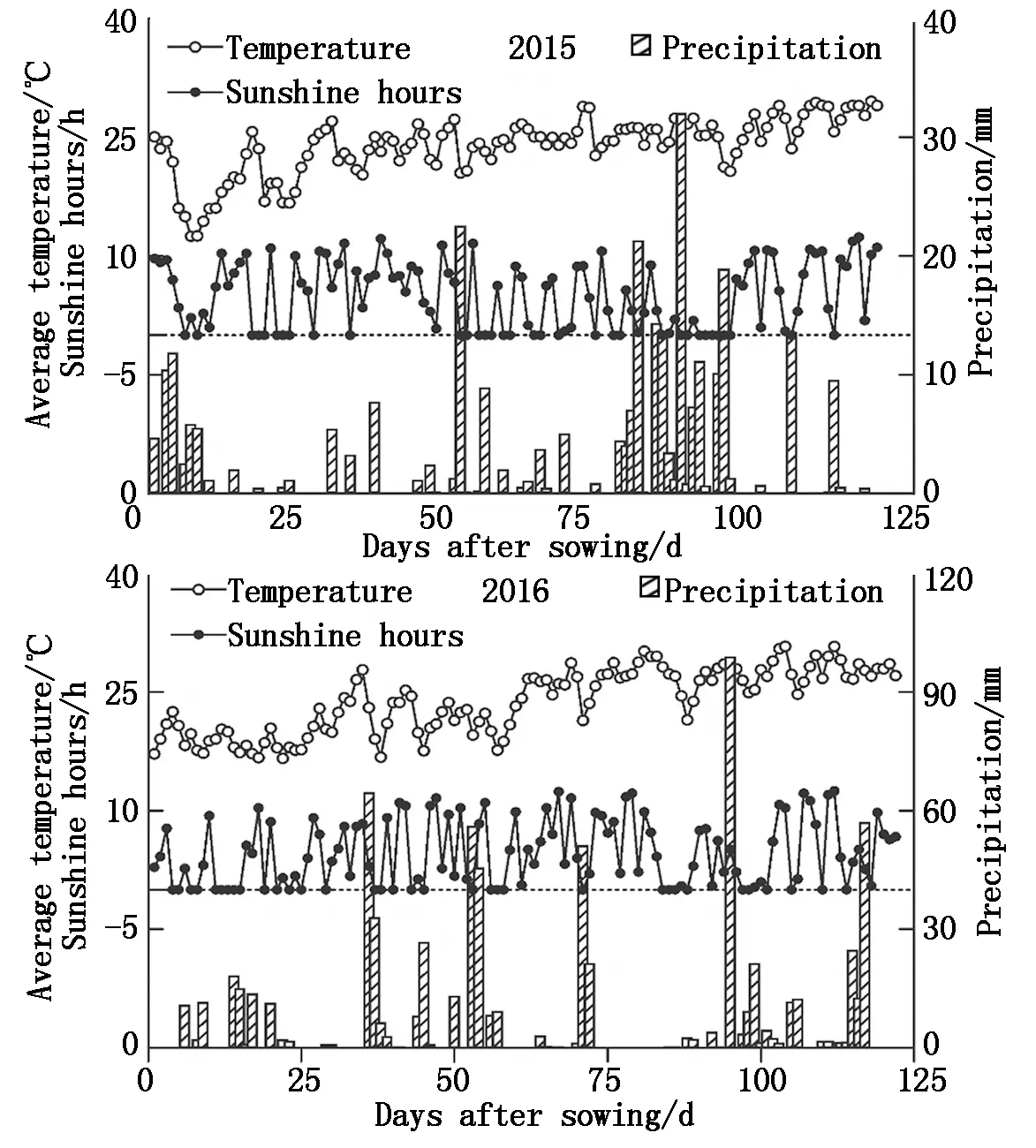
Fig.1 Daily average temperature,sunshine hours, and precipitation during the growing season of maize in 2015 and 2016
1.2 Plant materials
We used two maize hybrids with different N efficiency levels,i.e.,ZH311 and XY508[12]. ZH311 was developed in 2006 by the Sichuan Nongda Zhenghong Seed Co.,Ltd,Sichuan Province,China,while XY508 was developed in 2005 by the Pioneer Technology Co.,Tieling,Jilin Province,China.
1.3 Experimental design
We used a randomized block experimental design with three replicates. The plots were 7.5 m long,with six rows spaced by 1.4 m+0.6 m. Two hybrids(ZH311 and XY508)and five N treatments were randomly assigned to each replicate. The five N treatments were:①No N application(B1);②N 225 kg/ha(100% basic fertilizer,B2);③N 225 kg/ha(75% basic fertilizer+25% topdressing,B3);④N 225 kg/ha(50% basic fertilizer+50% topdressing,B4);⑤N 225 kg/ha(25% basic fertilizer + 75% topdressing,B5). The basic N fertilizer was applied before sowing,and the topdressing N fertilizer was applied at the V8 stage. Plots were fertilized with 75 kg/ha P2O5and 90 kg/ha K2Obefore sowing. No irrigation was used during the whole growing season,except during seeding. Disease,pest,and weed controls in each treatment were well controlled by routine management.
1.4 Sampling and measurements
At the V12 stage,VT stage,and R6 stage,samples were randomly collected from four plants with an average height from the middle of each plot,and samples were divided into stem plus sheath,leaf lamina,and panicle. Fresh samples were oven-dried at 105 ℃ for 60 min and then at 75 ℃ until a constant weight to determine the dry matter weight. The dry samples were milled and sifted through a 0.5 mm screen to determine the N concentration using a Kjeldahl apparatus(Kjeltec-8400;Foss Analytical,Höganäs,Sweden).
For soil inorganic N accumulation analysis,five 80 cm-deep soil cores were obtained from each plot and separated into 0—20 cm,20—40 cm,40—60 cm,and 60—80 cm soil layers before sowing,pre-topdressing,and post-harvest. According to the method of Deng et al[8],fresh soil samples were immediately dissolved after mixed by 2 mol/L potassium chloride solution(soil solution ratio,1∶5). The content of NH4-N and NO3-N was analyzed by an automated continuous flow analyzer(Alliance/FUTURA+/E,France).Meanwhile,the soil bulk density and moisture content were determined by the cutting ring method and oven-drying at 105 ℃.
1.5 Calculation methods
The N redistribution pre-silking and N accumulation post-silking were calculated as follows:
N redistribution amount(NRA,t/ha)= N accumulation of vegetative organs at VT-N accumulation of vegetative organs at R6;
N redistribution rate(NRR,%)= NRA/N accumulation of vegetative organs at VT;
Contribution of NRA to grain yield(CNRA,%)=NRA/N accumulation of grain×100;
N accumulation into grain post-silking(NAG,t/ha)=N accumulation of grain-NRA;
Contribution of NAG to grain(CNAG,%)=NAG/N accumulation of grain × 100.
The method described by Gu et al[9]was used to calculate the N dry matter production efficiency(NDMPE),N physiological efficiency (NPE),N uptake efficiency (NUE),N recovery efficiency (NRE),N agronomic efficiency (NAE),N partial factor productivity (NPFP),and N harvest index(NHI)as follows:
NDMPE(kg/kg)=Dry matter accumulation of plant/N accumulation of plant;
NPE(kg/kg)=(Yield of N application-Yield without N fertilizer)/(N accumulation of N application-N accumulation without N fertilizer);
NUE(%)=Total N accumulation/Total N supply(N application + Soil inorganic N before sowing) ×100;
NRE(%)=(N accumulation of N application-N accumulation without N fertilizer)/ Total N application amount×100;
NAE(kg/kg)=(Yield of N application-Yield without N fertilizer)/Total N application amount;
NPFP(kg/kg)=Yield of N application / Total N application amount;
NHI=Grain N accumulation/Plant N accumulation.
According to previous studies[8-9]the apparent N mineralization(ANM)during the maize growing season was calculated as the difference between N output,i.e.,plant N uptake + residual soil Nminin 0—80 cm soil layers,and N input,i.e.,initial soil Nminin the 0—80 cm soil layers,in the plots with no N treatment. The apparent N losses(Nloss)were calculated as follows:
Nloss(kg/ha)=(Initial soil Nminin the 0—80 cm soil layers+N fertilizer rate +ANM)-(Residual soil Nminin the 0—80 cm soil layers+Plant N uptake).
1.6 Data analysis
Data were analyzed with three-way analysis of variance(ANOVA)using the SPSS software package(Version 20.0)to test whether significant differences existed between the N treatments and cultivars. The statistical significance of differences between means was determined by least significant difference(LSD)test at the 0.05 probability level. Graphs were prepared using Graph Pad Prism 5.0.
2 Results and Analysis
2.1 Nitrogen accumulation and distribution
N management and cultivar type affected N accumulation in various stages and throughout the growth period. N accumulation of ZH311 was 16.51%,41.29%,26.73%,and 20.65% higher during the sowing stage—V12,V12—VT,VT—R6,and over the whole growth period than that of XY508 in 2015 and 30.00%,7.56%,12.18%,and 18.93% higher in 2016,respectively(Tab.2). Except for those during V12—VT in 2016,N accumulation differences between the two cultivars were highly significant(P<0.01). N accumulation differences between the two cultivars in 2015 were evidently higher than those in 2016 owing the fertility of the tested soils in 2016 being higher than that in 2015,indicating that N accumulation differences between maize cultivars were also closely related to soil fertility status. N management and its interaction with cultivar type had significant(P<0.05)effects on N accumulation in various stages(except for V12—VT in 2015)and for the whole growth period. A high base fertilizer ratio(B2)improved N accumulation during the sowing stage—V12 and VT—R6 of ZH311,and significantly increased N accumulation in the whole growth period compared to that of other treatments for both years. For XY508,high B2 increased N accumulation in sowing stage—V12,while high topdressing ratio(B5)increased N accumulation in V12—R6,which led to the N accumulation with B5 being higher than others in both years.

Tab.2 Nitrogen accumulation in maize in different growth periods kg/ha
N distribution ratio in maize stem plus sheath was highest in V12,and the proportion of N in leaves was highest in VT,while that in the panicle was highest in R6(Tab.3). In ZH311,the proportion of N in the stem plus sheath and leaves during VT and R6 was significantly(P<0.01)higher than that for XY508. In 2015, N proportion in stem plus sheath and that in leaves was higher by 15.07 percentage points and 4.14 percentage points at VT, and 12.55 percentage points and 25.94 percentage points at R6, respectively. Meanwhile, these factors were higher by 2.25 percentage points, 6.50 percentage points, 5.69 percentage points, and 16.61 percentage points, respectively, in 2016. The higher N partitioning ratio of stem plus sheath during VT of ZH311 could promote the absorption and transport of nutrients,which was beneficial to the nutrient absorption capacity of roots. Meanwhile,the higher N distribution ratio of leaves of ZH311 in R6 could delay leaf senescence in the late growth stage to maintain high biomass production capacity. Considering the whole growth period,N application increased N distribution in the stem plus sheath and decreased the N proportion in leaves of maize. B2 increased the N proportion in the stem plus sheath and decreased the N distribution ratio in leaves,which resulted in the highest N proportion in the stem plus sheath and the lowest N proportion in the leaves. High N proportion in the stem plus sheath and low N distribution in the leaves may be important to achieve high biomass and N accumulation under high B2.
2.2 Nitrogen redistribution and transformation
N management and cultivar type both had significant effects on pre-silking N transport and post-silking N transformation. Results showed that the NAG and CNAG of ZH311 were significantly(P<0.01)higher than those of XY508 in both years(Tab.4),with NAG being higher by 40.39% and 30.30%,and CNAG being higher by 9.31 and 2.84 percentage points in 2015 and 2016,respectively. Meanwhile,the NRR and CNRA of XY508 were significantly(P<0.01)higher than those of ZH311 in both years,and with NRR being higher by 9.56 and 4.02 percentage points,and CNRA being higher by 9.31 and 3.13 percentage points in 2015 and 2016,respectively. These results indicated that the differences in grain N accumulation between different N-efficient maize cultivar swere mainly derived from post-silking N transformation. The higher N accumulation of the N-efficient cultivar inhibited the transport of N accumulated pre-silking,leading to NRR and CNRA being significantly lower than those of the N-inefficient cultivar. N management had a significant effect on pre-silking N transport and post-silking N transformation in maize(P<0.01). In the two-year trial,the NRA of ZH311 was highest under the B4 treatment,while that of XY508 was highest under the B2 treatment. Meanwhile,the post-silking N accumulation was highest under B5 treatment in both cultivars. This indicated that balanced N management during the growth period(B4)was beneficial for the promotion of pre-silking N transport and increase of post-silking N accumulation of the N-efficient cultivar ZH311,leading to high N accumulation. High base fertilizer ratio(B2)could promote the pre-silking N transport of N-inefficient cultivar,while high topdressing ratio(B5)could improve the post-silking N accumulation,which led to N accumulation of XY508 under B2 and B5 being higher those under other N management scenarios.

Tab.3 Nitrogen distribution ratios of maize organs subjected to various treatments %
2.3 Nitrogen absorption and utilization
There was a significant difference in N uptake and utilization efficiency between maize cultivars(Tab.5). NUE,NRE,and NPFP of ZH311 were significantly higher(P<0.01)than those of XY508 in both years,with NUE being higher by 8.23 and 9.00 percentage points,NRE being higher by 2.75 and 5.25 percentage points,and NPFP being higher by 11.94% and 11.00% in 2015 and 2016,respectively. These results indicated that the advantages in N uptake and utilization of ZH311 compared with XY508 were mainly reflected in NUE,NRE,and NPFP,while the differences between the two cultivars in NDMPE,NPE,NAE,and NHI were affected by the tested soil and climatic conditions. The interaction between N

Tab.4 Effects of nitrogen management on redistribution of pre-silking nitrogen and transformation of post-silking nitrogen
management and cultivar type had significant(P<0.01)effects on the N uptake and utilization efficiency of maize. For ZH311,NUE and NRE were the highest under the B2 treatment in both years,and NAE and NPFP were the highest under the B4 treatment for both years,while those of XY508 were the highest under the B5 and B2 treatment in 2015 and 2016,respectively. Taken together,the results from both years indicated that the advantage of ZH311 over XY508 regarding N uptake and utilization was more pronounced under the B4 treatment than that under the B2 and B5 treatments,showing that balanced N management during the growth period(B4)could promote the N uptake and utilization of N-efficient maize cultivars,while relatively higher base fertilizer and topdressing ratios could also improve the N uptake and utilization of N-inefficient maize cultivars.

Tab.5 Effects of nitrogen management on nitrogen absorption and utilization of maize
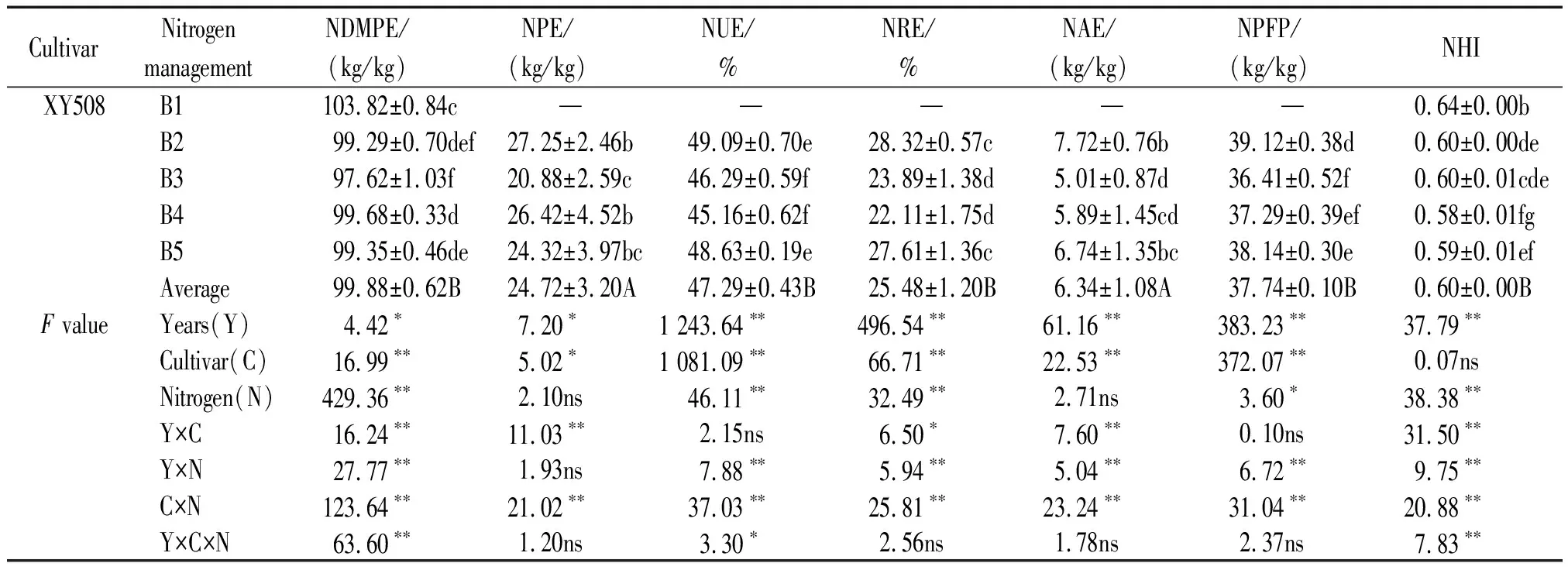
Tab.5(Continued)
2.4 Nitrogen balance
N management,cultivar types,and their interaction had significant effects on inorganic N accumulation in different soil layers(Tab.6). Soil inorganic N accumulation in the 0—20 cm soil layer pre-topdressing and post-harvest of ZH311 were higher than those of XY508,while those in 20—80 cm soil layers of XY508 was higher than those of ZH311. In 2016,the soil inorganic N accumulation in the 0—40 cm soil layers pre-topdressing and post-harvest were higher than those of XY508,and those in 40—80 cm soil layers were lower than those of XY508. Soil inorganic N accumulation pre-topdressing and post-harvest in the topsoil(0—40 cm)and lower soil(40—80 cm)of ZH311 were higher and lower,respectively,than those in XY508.
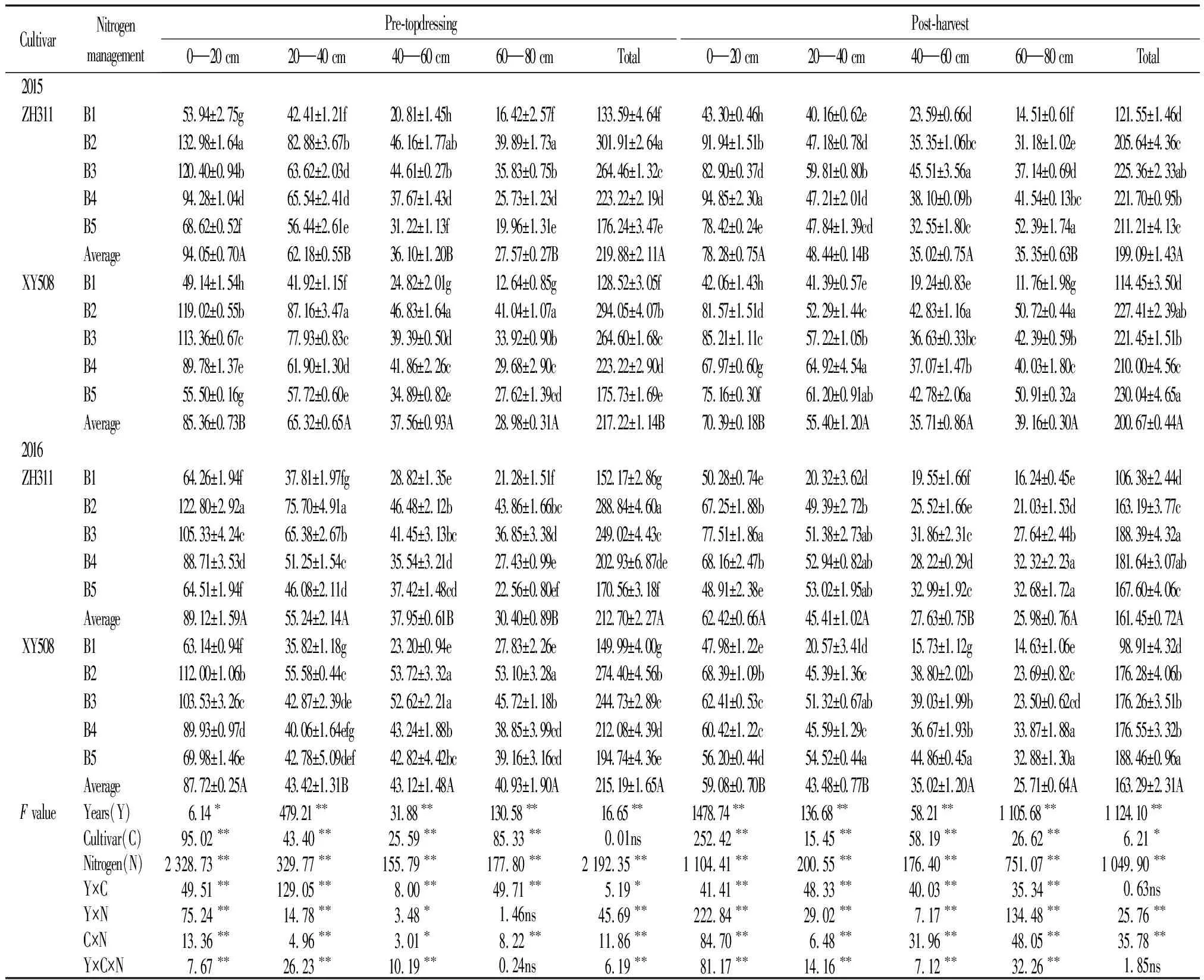
Tab.6 Effects of N management on inorganic N accumulation in different soil layers kg/ha
These results indicated that compared with XY508,ZH311 could better absorb and utilize nutrients in the soil low layers,maintain nutrients in the topsoil,reduce inorganic N deposition,and decrease the risk of N loss. The soil inorganic N accumulation pre-topdressing of both cultivars decreased significantly with increasing topdressing ratio in both years and was the highest under the B2 treatment in all soil layers. The soil inorganic N accumulation post-harvest of ZH311 under the B3 and B4 treatments was significantly higher than that in other treatments for both years,while that in XY508 was the highest under the B5 treatment in both years. These results showed that the differences between different maize cultivars regarding N uptake were mainly found in the post-topdressing period. These results suggested that balanced use of fertilizers during the growth period was beneficial for maintaining efficient N uptake levels in the N-efficient cultivar during the whole growth period,while a high topdressing ratio could improve N supply in the later growth period for N-inefficient cultivars.
Temperature and rainfall were important factors leading to N loss. High rainfall and temperatures in the late growth period of maize in Southwest Hilly Regions caused high N loss levels(Tab.7). Excluding the treatment with no N,the apparent N loss from the maize production system was 75.93—125.40 kg/ha,and the apparent N loss rate reached 16.40%—27.08%. Considering the cultivars,the total N output of ZH311 was significantly(P<0.01)higher than that of XY508 in both years,by 7.21% and 8.70% in 2015 and 2016,respectively. The low total N output led to the apparent N loss and loss rate of XY508 being significantly(P<0.01)higher than that of ZH311,by 32.10% and 5.95 percentage points in 2015 and 40.05% and 7.16 percentage points in 2016,respectively. Compared with that of N-inefficient cultivar,the total N output increased in the N-efficient cultivar by efficient N absorption,thereby effectively decreasing the apparent N losses and loss rate of the maize production system and reducing the risk of environmental pollution caused by N application.
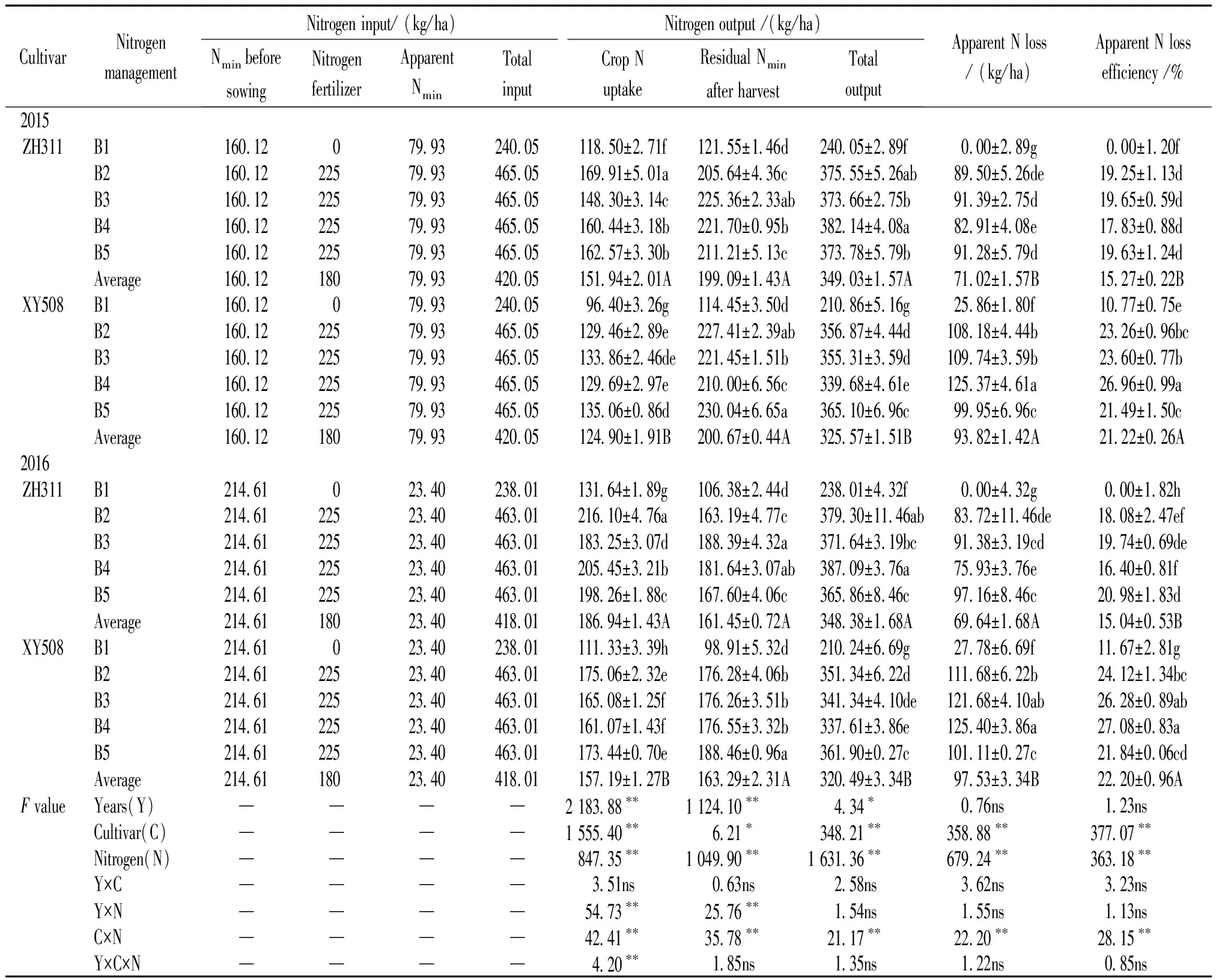
Tab.7 Nitrogen balance in soil-maize systems subjected to different treatments
N management had a significant(P<0.01)effect on N total input,total output,apparent N losses,and loss rate in the maize production system(Tab.7). ZH311 exhibited the highest total N output under the B4 treatment in both years,which resulted in the lowest apparent N losses and loss rate under the B4 treatment for both years. Meanwhile,XY508 had the highest total N output,and the lowest apparent N losses and loss rate under the B5 treatment for both years. The differences in apparent N losses between the two cultivars initially increased and then decreased with increasing N topdressing ratio and were the largest under the B4 treatment in both years,with those of XY508 being 42.46,49.47 kg/ha higher than those of ZH311 in 2015 and 2016,respectively. Balanced application of N fertilizer during the growth period could promote N uptake and maintain higher post-harvest soil N nutrition of N-efficient cultivars. This led to a significant decrease in apparent N losses compared to that in the other treatment,while a high topdressing ratio could increase soil inorganic N accumulation and improve N uptake in the N-inefficient cultivar,leading to the lowest apparent N losses in all treatments.
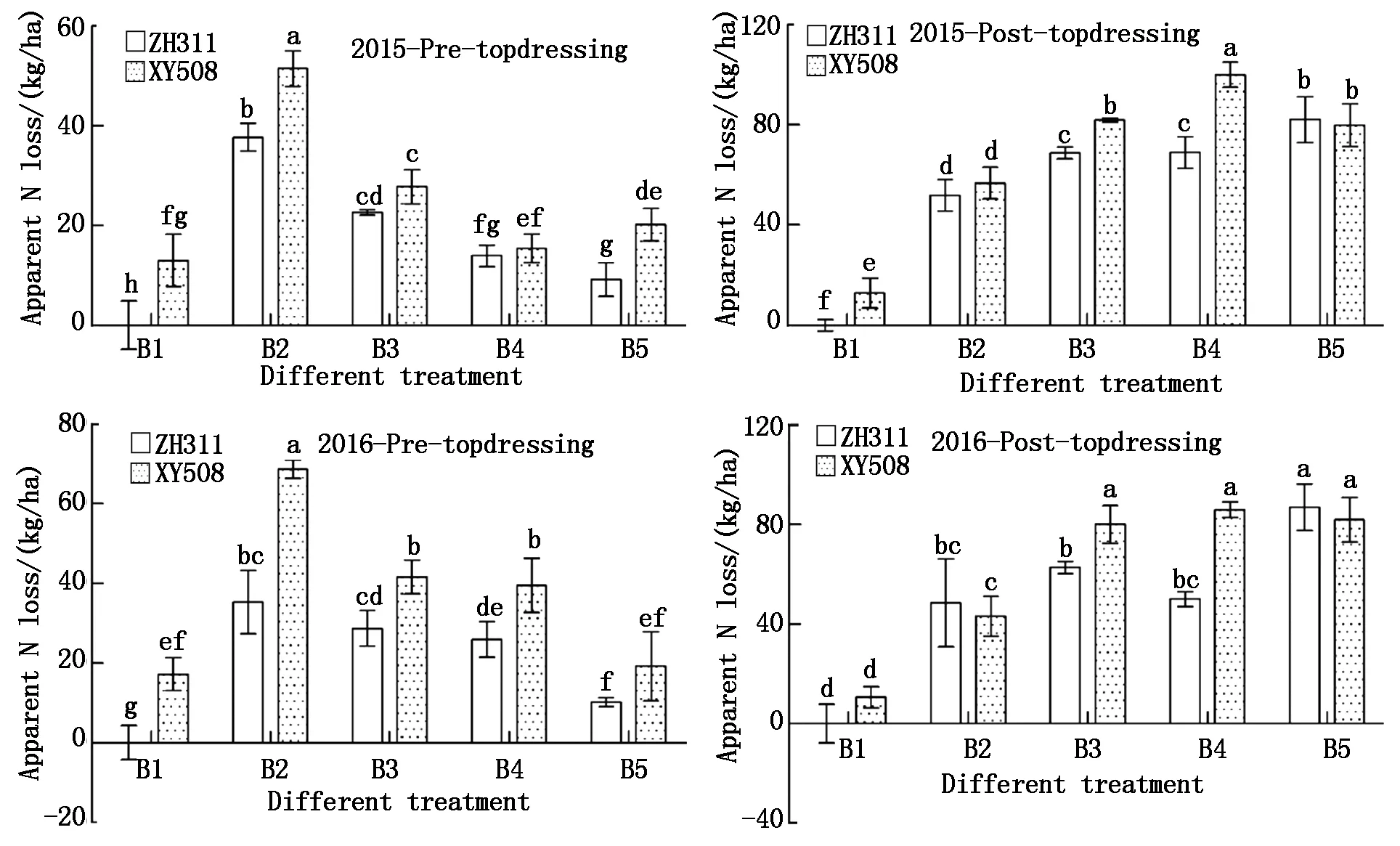
Data are mean ±s of three replicate pots. Values with different lowercase letters are significantly different at P<0.05.
The apparent N losses post-topdressing were higher than those pre-topdressing by 190.57% and 92.13% in 2015 and 2016,respectively(Fig.2),indicating that maize apparent N losses mainly occurred in the middle and late growth periods. Pre-topdressing and post-topdressing apparent N losses of XY508 were higher than those of ZH311 by 8.89,22.80 kg/ha in 2015,and 17.21,27.89 kg/ha in 2016,respectively. Pre-topdressing apparent N losses of the two cultivars exhibited the same trend,decreasing with increasing topdressing ratio,and those of the B2 treatment were the highest in both years.
There was a significant interaction between the effect of N management and cultivar on post-topdressing N losses. The post-topdressing apparent N losses of ZH311 were lower than those of XY508,and increased with increasing of topdressing ratio,being the highest under the B5 treatment. Contrastingly,those of XY508 first increased and then decreased with increasing topdressing ratio,being the highest under the B4 treatment. This showed that the higher N uptake ability of ZH311 compared to that of XY508 could effectively control the post-topdressing apparent N losses,while higher topdressing ratios promoted the N uptake of XY508 in the late growth stage,alleviating the post-topdressing apparent N losses.
3 Discussion and Conclusions
N accumulation of maize is closely related to soil basic fertility,meteorological factors,and cultivation management. Higher soil basic fertility and suitable rainfall made the N accumulation in 2016 significantly higher than that in 2015. Results showed that the N accumulation in the different stages of ZH311 was higher than that of XY508,and that the advantages of ZH311 were particularly evident in post-silking. Similar to the results of Li et al[17]using Xianyu 335 and Nongda 108,obtaining N-efficient cultivars could maintain the proportion of N in vegetative organs during the late growth stage to delay leaf senescence and improve N accumulation. Under high base fertilizer ratio(100% base fertilizer),the N accumulation and dry matter accumulation were higher than with other management types. Meanwhile,taking together the results of both years,the highest yield of ZH311 was under the B4 treatment(50% base fertilizer + 50% topdressing ratio)and that of XY508 was under the B5 treatment(75% base fertilizer + 25% topdressing ratio). This showed that although high base fertilizer ratio could significantly improve N accumulation and dry matter production of maize,this could not be translated into yield advantage,which may be caused by excessive vegetative growth in the early stage,affecting the transformation to reproductive growth,and ultimately grain yield. The effect on the N-efficient cultivar was more evident than that on the N-inefficient cultivar. Therefore,the amount of N fertilizer should be controlled in the early growth stage for N-efficient maize cultivars.
In addition to increasing grain yield and ammonia volatilization loss,the soil residual inorganic N content can directly reflect whether the application of N fertilizer is reasonable. Previous studies have shown that N application could significantly increase the inorganic N content in the topsoil of agricultural land post-harvest,while higher residual inorganic N increases soil N supply capacity and the underground migration of N to groundwater pollution[27-28]. These results indicated that high base fertilizer significantly increased the soil inorganic N accumulation of maize pre-topdressing,while the soil inorganic N accumulation post-harvest was greatly affected by cultivar type. The soil inorganic N accumulation post-harvest of ZH311 was the highest under the B3 and B4 treatments,while that of XY508 was the highest under the B5 treatment for both years. Regarding soil layer,the soil inorganic N accumulation in the 0—40 cm soil layer pre-topdressing and post-harvest of ZH311 was significantly higher than that of XY508,while that in the 40—80 cm soil layer of XY508 was obviously higher than that of ZH311. This indicated that the root system of ZH311 could absorb and utilize 40—80 cm soil inorganic N more efficiently,and could not only maintain higher soil nutrients in the topsoil layer,but also decrease the N deposition and reduce the risk of environmental pollution compared to that of XY508.
Increasing grain yield while improving the absorption and utilization efficiency of N fertilizer is an important goal for reducing environmental pollution and improving the sustainability of agricultural development[23]. Li et al[29]showed that the N-efficient maize cultivar fully absorbed and utilized N,and had NRE,NAE,and NPFP higher than those of the N-inefficient cultivar. Our results showed that the NAG and CNAG of ZH311 were evidently higher than those of XY508,which led to the NUE,NRE,NAE,and NPFP of ZH311 being significantly higher than those of XY508,while XY508 had higher NRR and CNRA that led to the NHI of XY508 being higher than that of ZH311 in both years. The difference of NUE(1 081.09**)between the two cultivars was significantly higher than the other indicators in both years,indicating that the N efficiency of ZH311 compared to that of the N-inefficient cultivar XY508 was mainly reflected in nitrogen uptake.
Reasonable N application is one of the important ways to improve N absorption and utilization efficiency of crops[8-9]. The higher N accumulation of ZH311 under the B2 treatment made the NUE and NRE of B2 higher than those of other treatments. Moreover,ZH311 grain yield under the B4 treatment led NAE and NPFP under this treatment to be the highest in both years. XY508 had higher N accumulation and grain yield both B2 and B5,which led to N absorption and utilization of B2 and B5 being higher in both years. These results indicated that balanced fertilization during the growth period(50% base fertilizer + 50% topdressing ratio)of N-efficient cultivar ZH311 could not only maintain high N absorption and utilization efficiency,but also obtained the highest grain yield. Moreover,both high base fertilizer ratio(100% base fertilizer)and high topdressing ratio(75% base fertilizer + 25% topdressing ratio)could improve grain yield and N absorption and utilization efficiency of N-inefficient cultivar XY508.
N balance requires the quantification of total N input(soil inorganic N,mineralized N,N fertilizer and other N)and total N output(plant N accumulation,N loss,and soil inorganic N)throughout the growth period. This is widely used to evaluate the sustainability and efficiency of N management,and the ability to maintain soil fertility in agricultural production systems. Compared with that of the N-inefficient cultivar XY508,the total N output of the N-efficient cultivar ZH311 significantly increased through high crop N uptake,thereby significantly reducing the apparent N losses,which decreased by 24.30% and 28.60% in 2015 and 2016,respectively. On average,the apparent N loss of ZH311 increased by 70.62,56.69 kg in 2015 and 2016,respectively,for each additional ton of maize grain,while that of XY508 increased by 100.64,61.12 kg,respectively. These results showed that the N-efficient maize cultivar could more effectively reduce apparent N losses compared to the N-inefficient cultivar,and that the N lost to the environment during the production of equivalent grain yield was significantly lower for the N-efficient than for the N-inefficient cultivar. Therefore,the popularization and planting of N-efficient cultivars could be of great significance for the environmental sustainability of maize production.
A large amount of N fertilizer input increased the chance of N loss in the early stage of fertilization. Results showed that the apparent N loss post-topdressing was significantly higher than that pre-topdressing,and that the differences between the two cultivars in apparent N loss post-topdressing were significantly higher than those pre-topdressing. This was caused by the topdressing of maize in the hilly area of Sichuan meeting the high-temperature and high-rainfall period causing N loss,while the efficient N absorption by N-efficient cultivars could effectively reduce apparent N loss,especially during the early period of topdressing. This result was consistent with those of Chen et al[3],i.e.,compared to N-inefficient cultivars,N-efficient cultivar can significantly reduce apparent N losses by reducing ammonia volatilization,N2O emissions,N leaching and runoff,and the differences between two types cultivar in apparent N losses mainly appear post-topdressing.
High N proportion in the vegetative organs of N-efficient cultivar ZH311 led to a significantly higher level of N accumulation in each stage than that of the N-inefficient cultivar XY508. Moreover,the N accumulation advantage of ZH311 was higher after silking. The high post-silking N accumulation of ZH311 reduced the pre-silking N transport that determines N transport and contribution rates to grain of pre-silking N accumulation,which were significantly lower than those of XY508,while the ZH311 NUE,NRE,and NPFP were significantly higher than those of XY508. The root system of N-efficient cultivar ZH311 can more effectively absorb and utilize inorganic N in the 40—80 cm soil layer,reduce N deposition,and significantly decrease apparent N losses compared to the N-inefficient cultivar XY508. The differences between the apparent N losses of the two cultivars mainly occurred post-topdressing. In summary,compared to the N-inefficient cultivar XY508,the N-efficient cultivar ZH311 could not only increase the yield per unit area,but also reduce N losses,consequently reducing environmental risks. A substrate of 50% base fertilizer+50% topdressing was optimal for realizing the potential of this cultivar. Meanwhile,using 25% base fertilizer+75% topdressing treatment,N-inefficient cultivar XY508 could have similar effects on yield and N loss to those of ZH311.
